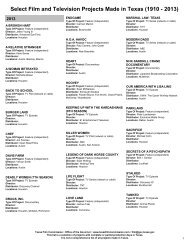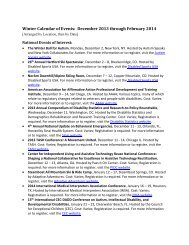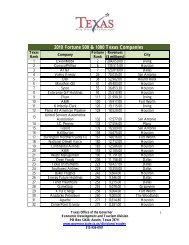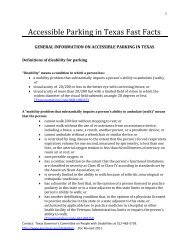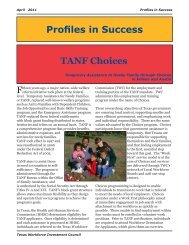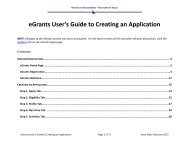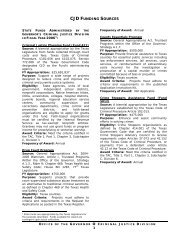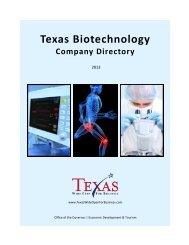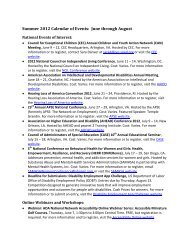People with Disabilities: A Texas Profile
People with Disabilities: A Texas Profile
People with Disabilities: A Texas Profile
You also want an ePaper? Increase the reach of your titles
YUMPU automatically turns print PDFs into web optimized ePapers that Google loves.
ating (33.2 percent) have a disability rating of 10 or 20 percent. Approximately 25 percent of <strong>Texas</strong><br />
veterans <strong>with</strong> a rating have a disability rating of 70 or higher.<br />
Table 18: Percentages of All <strong>Texas</strong> Veterans <strong>with</strong> Service‐Connected Disability Ratings, 2011<br />
Service Connected<br />
Disability Rating Number Percent<br />
0 percent 14,085 4.6%<br />
10 or 20 percent 102,796 33.2%<br />
30 or 40 percent 59,147 19.1%<br />
50 or 60 percent 37,460 12.1%<br />
70 to 100 percent 77,733 25.1%<br />
Not reported 18,078 5.8%<br />
Total 309,299<br />
Table notes: 2011 ACS microdata.<br />
Not all veterans <strong>with</strong> a service‐connected disability rating reported having a serious difficulty on the<br />
2011 ACS. Approximately 29 percent of veterans <strong>with</strong> a 10 or 20 percent disability rating also reported<br />
that they had a serious hearing, vision, cognitive, ambulatory, self‐care, or independent living difficulty.<br />
Approximately 62 percent of veterans <strong>with</strong> a 70 to 100 percent disability rating also reported having a<br />
serious disability on the ACS.<br />
<strong>Texas</strong> Youth <strong>with</strong> <strong>Disabilities</strong><br />
This subsection focuses on <strong>Texas</strong> youth – ages 16 to 24 – <strong>with</strong> disabilities. Data on these youth are from<br />
ACS microdata for the civilian noninstitutionalized population. Generally, the transition to adulthood for<br />
youth <strong>with</strong> disabilities is challenging (Stewart et al., 2008). Transitions into careers and postsecondary<br />
education for youth <strong>with</strong> disabilities can be particularly difficult. Some youth may feel that their career<br />
choices are limited because of the accommodations that they require, while others may be discouraged<br />
from pursuing further postsecondary education, thus limiting career opportunities.<br />
The most accurate method of illustrating the transition into postsecondary education or into a career<br />
from high school or college requires a longitudinal dataset in which the same individuals are followed<br />
over numerous years. However, the ACS dataset used in this report does not include longitudinal data.<br />
Therefore, comparison of youth <strong>with</strong> and <strong>with</strong>out disabilities is limited to a specific point in time. Of the<br />
3,308,352 <strong>Texas</strong> youth, 181,889 (5.5 percent) reported having a disability in 2011. Table 19 illustrates<br />
that six percent of youth attending secondary school in 2011 had a disability. However, secondary<br />
school attendance is normally compulsory until age 18 in <strong>Texas</strong>. Approximately three percent of youth<br />
attending college (including undergraduate and graduate education) in 2011 had disabilities.<br />
<strong>Texas</strong> Workforce Investment Council 29



